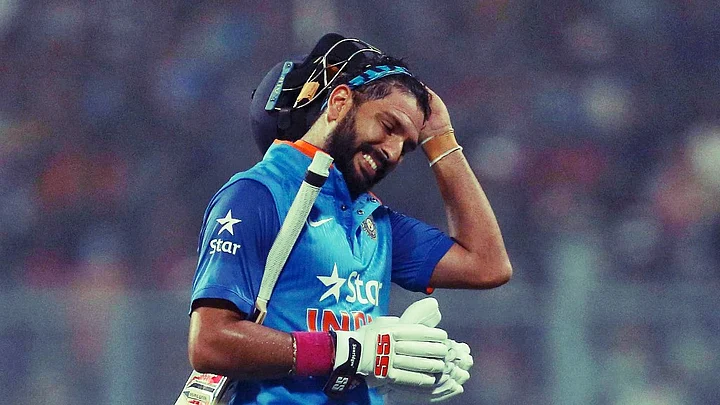Not many things can be learned from a washed out game in the Caribbean, except perhaps that it is foolish to schedule matches in that part of the world at this time of the year.
However, while India did bat just about 40 overs before the game was called off, a key point in the match that stood out was yet another batting failure of veteran Yuvraj Singh.
One could debate Yuvraj’s place in the team today, but that wouldn’t be a very long discussion. There is no real case for him, except maybe an appeal to emotion, while the case against him is armed to the teeth with cricketing logic. He’s 35, and is a liability in the field. He will almost certainly not last till the next World Cup. Above all, he is way past his prime as a batsman, and there is a lot of young, immensely talented blood waiting on the benches, raring to go.
After Anil Kumble’s resignation as team India’s head coach, journalist Prem Panicker hinted that the former leg-spinner had expressed concerns about Yuvraj batting at a number too high for his form.
This is something that cricket pundits have not quite addressed in the past, even though Yuvraj has batted more at No 4 than he has at any other position, and under various captains.
Numbers four, five, and six, are collectively labelled the middle-order of a batting line-up. While the idea of a specialist middle-order batsman wasn’t embraced for a long time in ODI cricket, it has been almost universally accepted in this century, and even more so with the advent of T20 cricket. Almost every team has specialists for the middle overs, who can also be counted on to finish the innings and/or score very quickly to give their team a boost.
One would think that a versatile middle-order batsman would generally have better numbers the further he moved up the order. It makes cricketing sense, because batting at No 4 means that you have more deliveries available to bat and, therefore, a bigger opportunity of scoring runs than at Nos 5 and 6. However, one could also argue that batting lower would mean a bigger opportunity to stay unbeaten or score faster and, therefore, have a better average and/or strike rate down the order.
So, instead of looking at only average and strike rate, let’s look at runs scored and balls faced per innings by Yuvraj at these numbers.
Strangely, there is hardly any discernible difference between Yuvraj’s numbers in different batting positions. If anything, they’re slightly better at No 5 than anywhere else. But before drawing any conclusions, let’s look at the same graph for MS Dhoni, who has batted alongside Yuvraj in the middle order for many years.
The first thing that stands out is that Dhoni is definitely a better batsman than Yuvraj as far as career numbers are concerned. But more importantly, Dhoni’s numbers show a clear and sharp rise the further he bats up the order. Ironically, Dhoni has spend most of his career batting at No 6. Now, just for the sake of another example, let’s look at another one of India’s middle-order batsmen in the same period, Suresh Raina.
The rise in performance may not be as sharp for Raina as it is for Dhoni, but it is still quite clear in the last two rows, especially from No 5 to 4.
These tables make several things quite clear, even about aspects of the game that cannot be measured in numbers.
Reading between the lines, it seems that the pressure on a No 6 batsman is quite high, and Dhoni’s stats at this position are a testament to his incredible ability to withstand pressure.
Yuvraj or Dhoni?
However, the primary thing to be noted is that Yuvraj Singh was never suited for the No 4 position, even when he was at his peak. Considering that he has played a lot of innings at each of these batting positions, it is clear that his numbers show no logical rise when he bats higher. Despite getting opportunities to play more balls and score more runs in relatively pressure-free situations at No 4, he has not fared any better at this position than he has at 5 and 6.
Despite all his incredible achievements, especially in the biggest matches, Yuvraj has always been quite limited as a batsman. He has a fixed shelf-life at the crease regardless of what number he bats at. This shelf-life probably makes him more suited for the No 5 position than anything else.
As captain, Dhoni’s decision to bat at No 6, despite it being a big personal sacrifice, seems like it wasn’t the most well-thought out one when you look at these numbers, because it is clear that he could’ve contributed more runs to the team at No 4.
However, since we’re not privy to many things that go on in the Indian dressing room, it isn’t entirely fair to be overly critical of it. It could’ve been that Dhoni knew that nobody else could be counted on to finish the innings on a regular basis, and he had to take on that responsibility himself.
But if the Indian cricketing think tank feels that Yuvraj belongs in the team, they need to take a serious look at these numbers and ask themselves whether he really belongs at No 4.
(At The Quint, we question everything. Play an active role in shaping our journalism by becoming a member today.)
